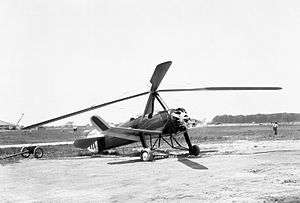Pitcairn PCA-2
| PCA-2 | |
|---|---|
 | |
| PCA-2 | |
| Role | Utility autogyro |
| National origin | United States |
| Manufacturer | Pitcairn-Cierva Autogiro Company |
| Designer | Harold F. Pitcairn |
| First flight | 1931 |
| Number built | 20–30 |
|
| |
The Pitcairn PCA-2 was an autogyro developed in the United States in the early 1930s,[1] Harold F. Pitcairn's first autogyro design to sell in quantity. It had a conventional design for its day – an airplane-like fuselage with two open cockpits in tandem, and an engine mounted tractor-fashion in the nose.[2] The lift by the four-blade main rotor was augmented by stubby, low-set monoplane wings that also carried the control surfaces.[2] The wingtips featured considerable dihedral to act as winglets for added stability.[2]
The PCA-2 was the first rotary-wing aircraft to achieve type certification in the United States[3] and was used in a number of high-profile activities including a landing on the White House lawn[4][5] and the first flight across the United States in a rotorcraft. This latter feat was attempted by Amelia Earhart, flying for the Beech-Nut food company, but was actually accomplished by John M. Miller who completed his flight nine days before Earhart on 28 May 1931, in his PCA-2 named Missing Link.[6] Learning of Miller's achievement upon her arrival in California, Earhart set out to turn her flight into a round-trip record by flying east again, but abandoned the attempt after three crashes.[6] Earhart set an altitude record in a PCA-2 on 8 April 1931 with a height of 18,415 ft (5,615 m).[2][3][4] This record was broken in another PCA-2 by Lewis Yancey who flew to 21,500 ft (6,600 m) on 25 September 1932.[3][7]

In 1931, The Detroit News made history when it bought a PCA-2 for use as a news aircraft due to its ability to fly well at low altitude, land and take off from restricted spaces, and semi-hover for better camera shots. In May 1933, Scripps donated the autogyro to the Henry Ford Museum in Dearborn, Michigan.[8]

The Champion spark plug company operated a PCA-2 as a promotional machine in 1931 and 32 as Miss Champion.[4] It was flown over 6,500 miles in the 1931 Ford National Reliability Air Tour. This machine was restored to flying condition in 1982 by Steve Pitcairn, Harold's son.[4] In 2005, he donated it to the EAA AirVenture Museum.[4] Other PCA-2s are preserved at The Henry Ford[4][9] and the Canada Aviation Museum.[10]
Variants
- PCA-2 - major production version[2][3]
- PCA-3 - version with Pratt & Whitney Wasp Junior engine and 48-ft (14.63-m) rotor[2] (1 built)[3]
- PA-21 - version with Wright R-975-E2 engine[2][3]
- OP-1 - Reconnaissance autogyro (1931)
- OP-2 - Reconnaissance autogyro without wings.
Specifications (PCA-2)
Data from "Pitcairn PCA-2 Autogiro Specifications"
General characteristics
- Crew: One pilot
- Capacity: 2 passengers
- Length: 23 ft 1 in (7.04 m)
- Wingspan: 30 ft 0 in (9.14 m)
- Main rotor diameter: 45 ft 0 in (13.72 m)
- Main rotor area: 1,590 ft2 (147 m2)
- Empty weight: 2,233 lb (1,015 kg)
- Gross weight: 3,000 lb (1,363 kg)
- Powerplant: 1 × Wright R-975-J6-9, 330 hp (250 kW)
Performance
- Maximum speed: 120 mph (190 km/h)
- Range: 290 miles (466,7 km)
- Service ceiling: 15,000 ft (4,575 m)
- Maximum glide ratio: 4.8[11]
See also
- Related development
Cierva Autogiro Company ; Buhl Aircraft Company ; Pitcairn Aircraft Company
- Aircraft of comparable role, configuration and era
Cierva C.19 ; Buhl A-1 Autogyro ; Pitcairn PA-18
References
- Notes
- ↑ Taylor 1989, p.735
- 1 2 3 4 5 6 7 The Illustrated Encyclopedia of Aircraft, p.2739
- 1 2 3 4 5 6 "Pitcairn, A G A, Pitcairn-Cierva, Pitcairn-Larsen"
- 1 2 3 4 5 6 "Pitcairn PCA-2 Autogiro 'Miss Champion' – NC11609"
- ↑ Charnov 2003b, p.3
- 1 2 Charnov 2003a
- ↑ Charnov 2003b, p.6
- ↑ Ford Richardson Bryan, Sarah Evans. Henry's attic: some fascinating gifts to Henry Ford and his museum.
- ↑ "The Planes: 1931 Pitcairn Autogiro"
- ↑ "Pitcairn-Cierva PCA-2"
- ↑ Duda, Holger; Insa Pruter (2012). "FLIGHT PERFORMANCE OF LIGHTWEIGHT GYROPLANES" (PDF). German Aerospace Center. p. 5. Retrieved 3 December 2012.
- Bibliography
- Charnov, Bruce H. (2003a). "Amelia Earhart, John M. Miller and the First Transcontinental Autogiro Flight in 1931". The Aviation History On-Line Museum. Retrieved 2009-01-17.
- Charnov, Bruce H. (2003b). From Autogiro to Gyroplane: The Amazing Survival of an Aviation Technology. Westport, Connecticut: Praeger Publishers.
- "Pitcairn-Cierva PCA-2". Canada Aviation Museum website. Retrieved 2009-01-17.
- "Pitcairn, A G A, Pitcairn-Cierva, Pitcairn-Larsen". Aerofiles. Retrieved 2009-01-15.
- "Pitcairn PCA-2 Autogiro 'Miss Champion' – NC11609". AirVenture Museum website. Retrieved 2009-01-17.
- "Pitcairn PCA-2 Autogiro Specifications". AirVenture Museum website. Retrieved 2009-01-17.
- The Illustrated Encyclopedia of Aircraft. London: Aerospace Publishing.
- "The Planes: 1931 Pitcairn Autogiro". The Henry Ford website. Retrieved 2009-01-17.
- Taylor, Michael J. H. (1989). Jane's Encyclopedia of Aviation. London: Studio Editions.
External links
| Wikimedia Commons has media related to Pitcairn PCA-2. |
| ||||||